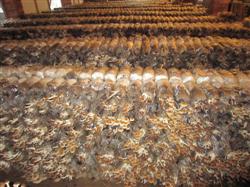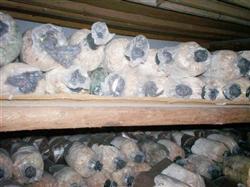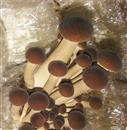How to grow tea mushroom on a large scale?

How to grow tea mushrooms? Please introduce the method of tea mushroom scale cultivation can refer to the following methods: 1. Construction of mushroom shed: whether it is indoor mushroom house, or outdoor mushroom house (or plastic greenhouse), according to the requirements of pollution-free production, environmental conditions must be optimized, soil, water quality, water pollution. Intensive production shed, can be adapted to local conditions. Bamboo and wood can be used as skeleton, and the mushroom house is composed of heat-insulating expanded plastic plates around. There are 6-7 layers of frame beds, 250-300 square meters per room, and 10,000 bags of one-time cultivation. Mushroom to health, heat preservation, moisture, ventilation, lighting reasonable. 2. Cultivation season: the mycelium growth temperature of Agrocybe chaxingu is 10-34 DEG C, and the optimum temperature is 24-28 DEG C; the fruiting body formation growth temperature is 12-34 DEG C, and the optimum temperature is 22-28 DEG C. The biological characteristics require that the cultivation season is arranged in spring and autumn. Spring is suitable for inoculation in February and fruiting in April; autumn is suitable for inoculation in August and fruiting in October, so that natural temperature can be fully utilized. 3. Fungus material technology: Chashinggu fungus bag production process: ingredients--stirring--bagging--sterilization according to conventional operations. Common culture medium formula: ① cottonseed hull 50%, miscellaneous sawdust 22%, wheat bran 20%, lime powder 2%, corn flour 5%, gypsum powder 1%;② tea seed hull 40%, cottonseed hull 32%, wheat bran 20%, lime powder 2%, corn flour 5%, calcium superphosphate 1%;③ miscellaneous sawdust 72%, wheat bran 20%, sucrose 2%, calcium carbonate 1%, calcium superphosphate 1%, gypsum powder 1%. The raw materials are different, and they are treated separately before mixing. The tea seed shells should be crushed into rice grains. First, they should be soaked in 1%-2% lime water for 10-14 hours, and then picked up for later use. Cottonseed hulls need to be added to water 24 hours in advance to allow them to absorb water. In order to prevent contamination by miscellaneous bacteria, lime water can also be used to pre-wet cottonseed hulls before mixing. The moisture content of culture medium should be controlled at 60%. Cultivation bag specifications: 15×32 cm (or 17×38 cm), 5 mm thick high-pressure polypropylene plastic bag commonly used for vertical bag cultivation. As a factory production plant, it is best to use the "space bag" automatic punching and bagging machine to increase production. 4. Inoculation culture: select the appropriate strains with good quality and no more than 80 days of age. When the bag temperature does not exceed 30 ℃ during inoculation, put the bacteria bag into the inoculation box. All kinds of inoculation equipment shall be disinfected by 75% alcohol and put into the inoculation box. Then, ignite and fumigate with disinfectant for 15-20 minutes for sterilization before starting inoculation. When inoculating, the bag mouth should be close to the flame of alcohol lamp, and the bag mouth should be downward. Except for a few strains, most strains should be placed on the surface of culture medium, and then the bag mouth should be tightened. After inoculation, the fungus bags are placed on a rack of a mushroom house for cultivation, the temperature is kept at 23-25 DEG C, the air humidity does not exceed 70%, and weak light scattering is carried out. Autumn planting bacteria often encounter high temperature, pay attention to sparse bag heat dissipation, strengthen ventilation and cooling, but also to prevent rodents, so as not to infect miscellaneous bacteria. 5. fruiting management: after the fungus bag is filled with hyphae, after about 10 days, when the accumulated temperature is 1600-2000 DEG C, move into the factory which has been disinfected in advance and open. Before opening, rinse the bacteria bag with 0.5% potassium permanganate liquid. After drying, cut a film bag with a small opening of about 3 cm (or cut off the tie opening) at the top of the bacteria bag with a blade, and cover with a film. In some places, farmers take a simple approach: unzip the bag, straighten the film, and cover it with newspaper. At this stage, the indoor temperature is maintained at 20-28 degrees Celsius, and the relative humidity of the space is 70%-75%. It is not advisable to spray water directly after opening, so as not to infect miscellaneous bacteria. If the humidity is too high after 5 days of opening, ventilation in the morning and evening for 10-15 minutes, humidity is too low, water spray can be used to humidify; 12-16 days after opening, space spray requires that the relative humidity of the air should reach 80%-90%; when a large number of mushrooms are produced, it is required to increase to 90%-95%, not exceeding 97%. The hypha changed from vegetative growth to reproductive stage, and the color of the material changed, yellow water appeared in the initial stage, then dark brown patches appeared, and then small mushroom buds appeared. As long as the temperature and humidity are suitable, the mushrooms will begin to grow one after another within 15-20 days after opening. 6. Timely harvest: from the mushroom bud to harvest generally 5-7 days, when the cap is hemispherical, the fungus ring has not yet separated from the handle to harvest, expired affect the quality of the product. After harvesting the first stage mushroom, stop spraying water for 5-6 days, let it resume hypha growth, and accumulate nutrients for the next stage mushroom. After 15 days, the air humidity is increased to more than 90%, which promotes the growth of the second stage mushroom. From the end of the first stage to the second stage, the interval is usually about 7-15 days. After that, according to the above management method, the third mushroom will be produced. After picking the third stage mushroom, if the matrix in the bag is dry and dehydrated, it can be cultivated by removing the bag and covering the soil, increasing the humidity, and continuing to grow mushrooms. As long as it is properly managed, it can produce more than 200-300 grams of fresh mushrooms per bag, and the dry weight is 30-50 grams. Click for more cultivation techniques of Agrocybe sinensis Click for more cultivation techniques of edible fungi
- Prev

How to manage the emergence period and emergence period of Pleurotus ostreatus?
How to manage the emergence period and emergence period of Pleurotus ostreatus? Please introduce the management of the emergence period and the emergence period of Pleurotus ostreatus can refer to the following methods: first, the cultivation bag after receiving the strain should be moved into the culture room in time for bacteria management, which requires ventilation, drying and shading. The space should be eliminated before placing the planting bag.
- Next

How to grow tea mushroom bag material?
How to grow tea mushroom bag material? Please introduce the planting method of tea mushroom bag material cultivation can refer to the following methods: 1, season selection. The growth temperature range of Pleurotus ostreatus is wide, the mycelium can grow at 8 ℃ 34 ℃, but the suitable temperature for fruiting body differentiation is 13 ℃-32 ℃, and the optimum temperature is 20 ℃-28 ℃. According to.
Related
- Fuxing push coffee new agricultural production and marketing class: lack of small-scale processing plants
- Jujube rice field leisure farm deep ploughing Yilan for five years to create a space for organic food and play
- Nongyu Farm-A trial of organic papaya for brave women with advanced technology
- Four points for attention in the prevention and control of diseases and insect pests of edible fungi
- How to add nutrient solution to Edible Fungi
- Is there any good way to control edible fungus mites?
- Open Inoculation Technology of Edible Fungi
- Is there any clever way to use fertilizer for edible fungus in winter?
- What agents are used to kill the pathogens of edible fungi in the mushroom shed?
- Rapid drying of Edible Fungi

